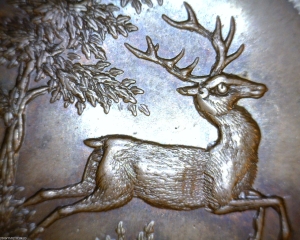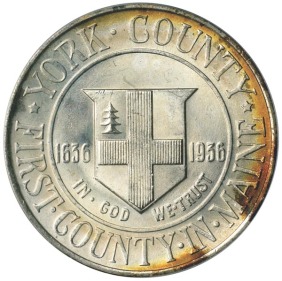Congratulations Dan, you have managed to accomplish something that all who love and collect large cents can share and enjoy with you into the future. Your perseverance over the last 35 years has resulted in an historical “first” for the coin collecting community on the whole, and particularly, for large cent collectors everywhere. To further distinguish your accomplishment, you compiled your collection by what we will call the “old school approach” of untiring patience in your search, meticulousness in your purchases, and all done with an “eye” for unwavering quality in your choice of copper. Your assembling the most complete set of Early Date US Large Cents in history is an event that will go down in numismatic history as one of the foremost events in our hobby.
Not only has Dan brought together all 302 Sheldon varieties in the early date years (1793-1814) in a single collection, but even more remarkably, he has managed to couple that with bringing together all 53 of the NC (noncollectible) varieties as well. Dan was able to obtain all of the noncollectible varieties but one. Through the generosity of the ANS, they have loaned to Dan that single unique coin, the 1793 NC-5, through his September auction to make it possible to display, and for collectors to view, a complete set by Sheldon number of United States Early Date Large Cents for the first time. This display contains all 355 varieties including the NC varieties of this remarkable era in our Early American history. What an amazing triumph!
The extent of Dan’s accomplishment has further been amplified by Bob Grellman when he noted that there are probably two dozen coins in this early date large cent collection whose rarity exceeds both the 1804 dollar and the 1913 Liberty nickel!! Another remarkable accomplishment!
And, there are over 50 coins listed as finest known for the variety, or condition census pieces including many of those described below.
The sale will take place September 6, 2009, at the Crowne Plaza Hotel in Beverly Hills at 1:00 PM with auctioneers Larry and Ira Goldberg in collaboration with Chris McCawley and Bob Grellman, The Copper Specialist. This continues to be a phenomal team for bringing high quality large cent auctions to the cutting edge for both collector and investor. We owe these gentlemen a great deal of gratidue in bringing us these landmark events. Thanks to you and you hard working staffs gentlemen!
We will mention a few highlights of the auction to further heighten your interest. We will give you the PCGS grade as well as McCawley and Grellman’s grade (The Copper Specialists/EAC grade).
Let’s begin with Lot 128, the legendary 1795 Reeded Edge Sheldon-79. This Holmes coin is the finest of 8 known examples (R7+). Even through the grade assigned by PCGS is only VG-10, the Reeded Edge is clear and strong with the exception of a small area over the S-OF-A where it is weak or missing. McCawley & Grellman give the coin a VG-10 designation. To help put this particular coin in perspective, a G-4 with heavy wear brought $402,500 (lot #1143) in the Nov. 20, 2008, Bowers and Merena auction in Baltimore. What will be the final hammer for this exceptional treasure, one of the most famous coins in the collection?
Probably considered to be the most valuable coin in the collection is Lot 352. This is the extraordinary Mint State 1799 Sheldon-189 (Normal Date). It is the only Certified Mint State coin of that year. It has been graded MS-62 BN by NGC. It is the superior coin for that year by a wide margin, the runner-up being a VF-30 example housed in the ANS Museum. Catalogers McCawley & Grellman give the coin an AU-55 designation. This is the “must-have” coin for anyone assembling a registry set of mint state large cents!
Lot 3 is another amazing coin. It is the second finest 1793 Sheldon-2 Chain America graded MS-63 BN by PCGS. It ranks as an R4+. This copper has incredibly well defined hair detail and magnificent surfaces beaming with luster. McCawley and Grellman assign this coin a grade of AU-55 due to the light friction on the highest points.
Lot 5 is another Chain America, the 1793 Sheldon-3, which is the Levick Plate Coin. It is an R3- and graded MS 63 BN by PCGS. McCawley and Grellman assign this coin a grade of AU-50+.
Lot 7 is the Unique 1793 Strawberry with One Cent Centered, NC-2, R8+, graded by PCGS as Fair 2. This is the Levick-Crosby Plate Coin. McCawley and Grellman assign this coin a grade of Fair-2+. An extraordinary coin!
Lot 8, also a 1793 NC-3 Strawberry Leaf Wreath Cent with the ONE CENT High is one of only three known and is referred to as the “Common Strawberry”. PCGS graded this coin as Good-4 with which McCawley and Grellman concur. The finest known example is a VG-7 (EAC grade) which sold for $862,500 as lot #51 in the January 5, 2009, Stack’s auction in Orlando. This set a record price paid for a large cent. Will it stand or fall during the Holmes auction?
Accordingly, in a single collection, Dan has assembled two of the four known examples of the Strawberry Leaf Wreath Cent.
Lot 9 is a Prooflike 1793 S-5 (R4) Wreath Cent with Large Date and Liberty. This is simply a near flawless Wreath Cent. The coin is sharply struck and has reflective prooflike surfaces. PCGS graded this coin MS-65 BN while McCawley and Grellman assign it a grade of MS-63 prooflike. NGC had graded the coin as Specimen-65 BN. This is simply another amazing coin in Dan’s collection. Auction estimates are $150,000-UP!
Lot 79 is yet another spectacular and popular coin for the large cent collector. It is the attractive high condition census 1794 Sheldon-48 (R5) Starred Reverse graded by PCGS as VF-30. A very rare coin indeed in this grade! McCawley and Grellman assign a grade of VF-25. In Dan’s example, all 94 stars are clearly visible and reflect the quality of this great collection. Someone will walk away with a pristine example of this popular variety. Once again, auction estimates are $150,000-UP!
Lot 1 is the American Classic 1793 Sheldon-1 (R4) Chain Ameri. graded by PCGS as AU-58. This coin represents one of the finest known of this variety. Graded AU-55 by McCawley and Grellman, this is a true American Classic.
Lot 24 is the Finest Known Bisected Obverse 1793 Sheldon-14, a R5 and residing in an AU-53 PCGS holder. McCawley and Grellman give this coin a grade of EF-45. With an estimate of $100,000 and UP, given the exquisite nature and rank of the coin, this is surely a figure which will be exceeded.
As we continue, Lot 31 is another remarkable mint state large cent. This lot is the lustrous 1794 Sheldon-18b, Head of 1793 with Edge of 1794 and is a R4. PCGS graded this coin as MS-63 (tied for the finest they have graded) whereas McCawley and Grellman assign a grade of MS-60. Estimated value for this coin is $100,000.
Lot 74 is the Finest Known 1794 Sheldon-45 (R5+), and the finest by a wide margin. There is no roughness or planchet flaws on this coin which is from the Oswald group of mint state early dates. PCGS graded the coin MS-65 RB, and McCawley and Grellman concur. An absolutely beautiful specimen with an auction estimate of $100,000 and UP.
Lot 95 is a Gem 1794 Sheldon-59 (R3-), another Oswald coin graded MS 66 RB by PCGS. McCawley and Grellman give the coin a grade of MS 65+ and note that it is certainly one of the finest 1794 cents of any die variety. An incredible gem in all respects as well as being from the famous Oswald collection. An auction estimate of $100,000 and UP.
Lot 101 is a Choice Mint State 1794 Sheldon-64 with Missing Fraction Bar, graded MS-64 RB by PCGS with an R5- rating. McCawley and Grellman assign a grade of MS-63 to this choice steel brown coin with ample mint red color remaining. Another coin with an auction estimate of $100,000 and UP. Surely a true rarity with a PCGS population of 1 and none finer at PCGS for the variety.
Lot 185 is a Gem 1796 Draped Bust Sheldon-110 with an R3+ rating and graded MS-66 BN by PCGS and MS 65 by McCawley and Grellman. Tremendous coin, possessing highly lustrous steel brown surfaces which have eloquently faded from the underlying mint red color which still remains strong in the protected areas. An incredible gem which makes the large cent enthusiast gasps for breath and weak at the knees.
Lot 531 is the Unique Certified Mint State 1804 Sheldon-266c Large Cent graded MS-63 BN by PCGS with an R2 rarity rating. This is the Sheldon Plate Coin. McCawley and Grellman assign a grade of AU-58. It is worth reading the description of this coin to understand the disparity in grade. In any event, this is the finest known in both census lists. This coin is a true prize for the most discerning collector of Early American Coppers.
Finally, also offeredd in this sale is the Unique Sheldon-Holmes Color Set. This set consist of 6 Colonials and 60 Large Cents assembled by Dr. Sheldon and sold intact to Dan in 1976. Auction estimate is $20,000-UP.
We all eagerly await September 6, 2009 to learn the outcome of his historical sale.
We also wish Dan the very best and look forward to the remaining three sales in 2010.
Read Full Post »















You must be logged in to post a comment.